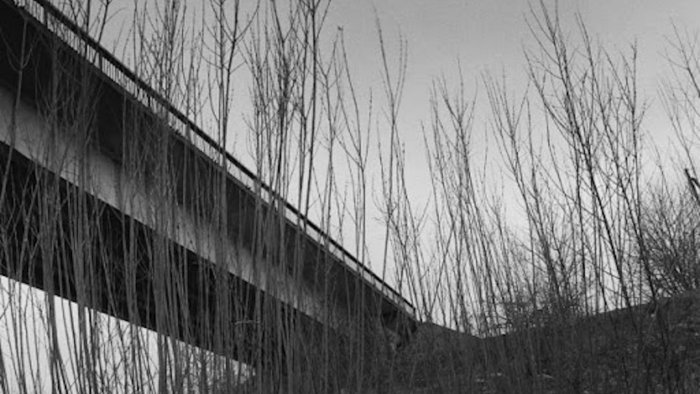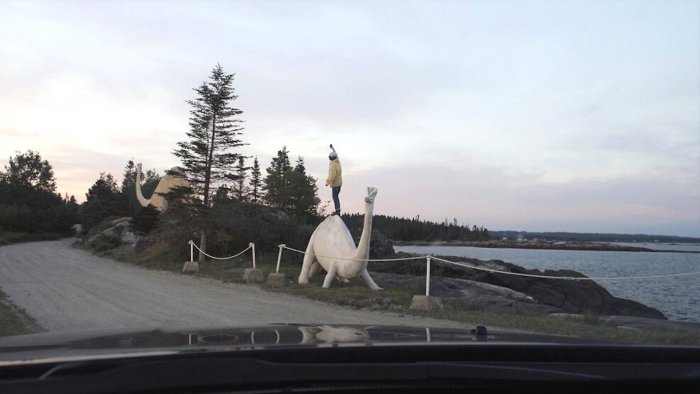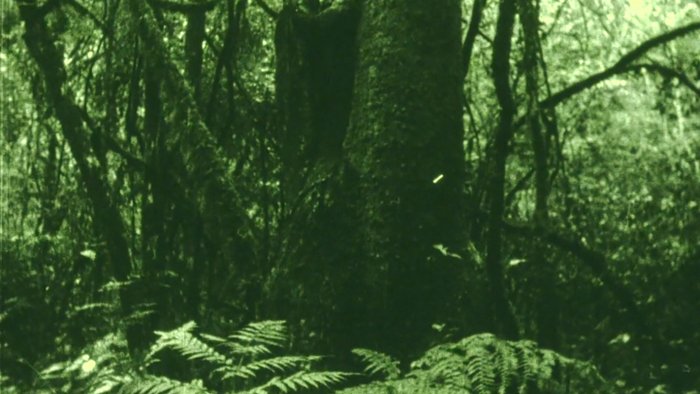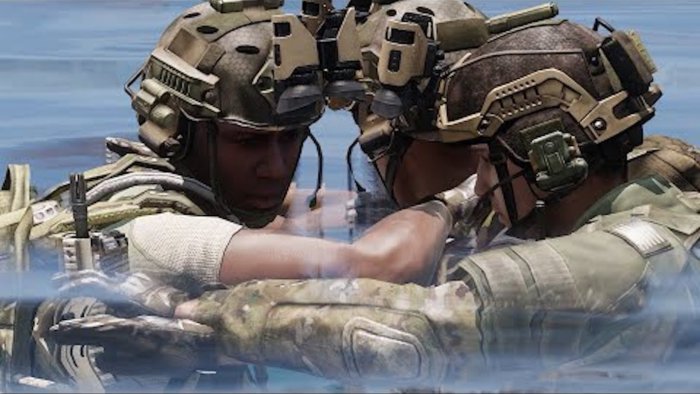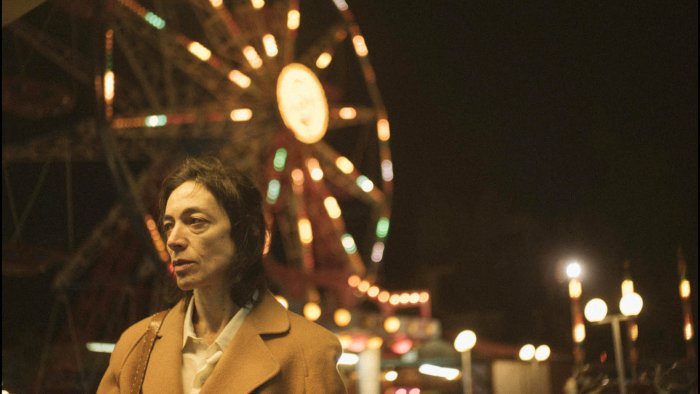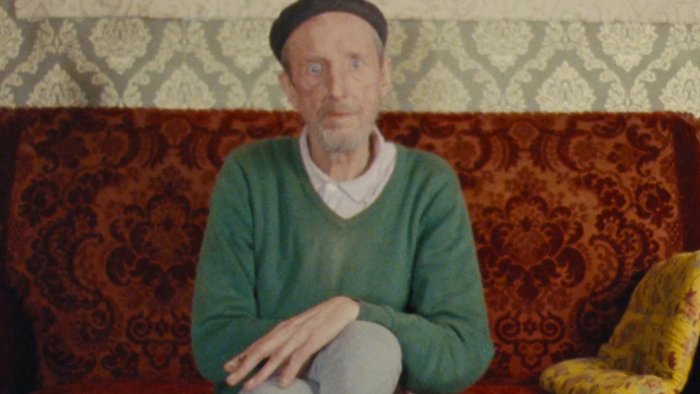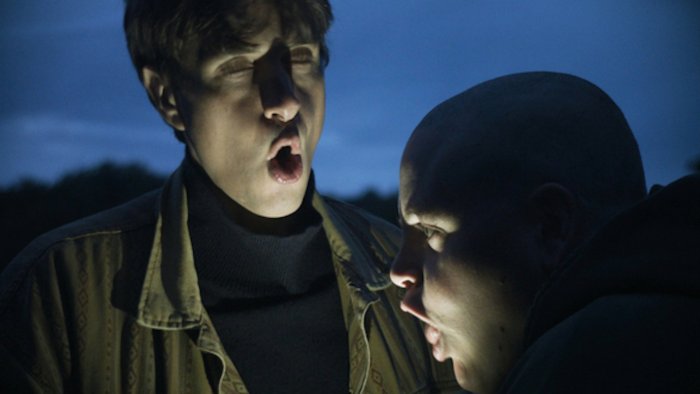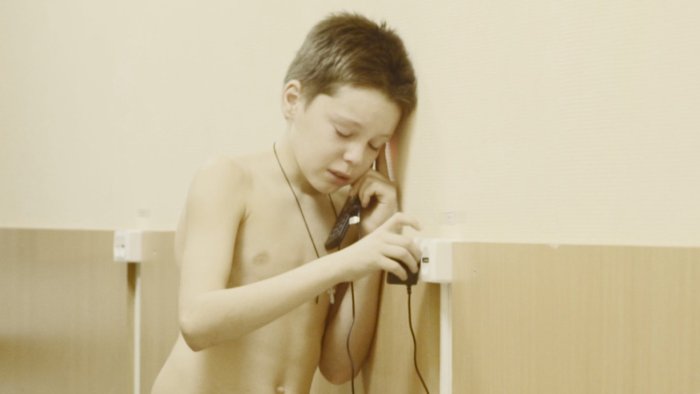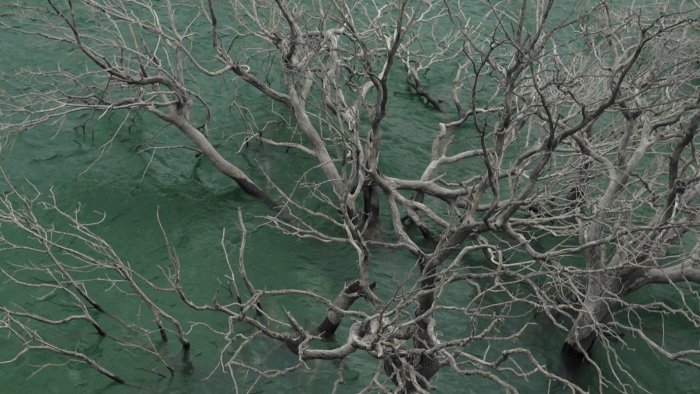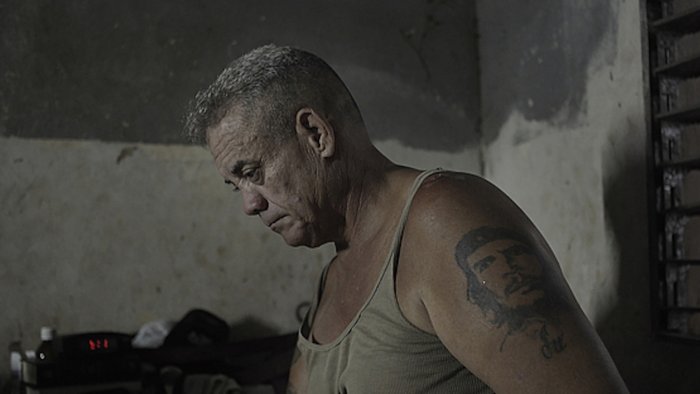Visions du Réel 2020
A selection of films from the competitions "Medium Lenght & Short Films" and "Opening Scenes"
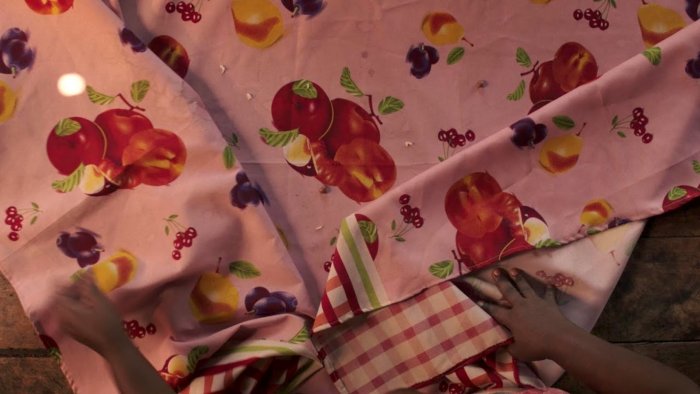
Contributions by Davide Abbatescianni, Emilien Gür, Giuseppe Di Salvatore, Jean Perret, Jodie McNeilly-Renaudie, Laura Davis, Matthias Wittmann, Ruth Baettig
This article contains a third-party video. If you would like to watch the video, please adjust your settings.
Thelyia Petraki | GR 2020 | 25’ | Visions du Réel 2020, Medium Length & Short Films
Bella is a love letter stitching together the scrapbook fragments of European politics in transition. Jagged cut frames of grainy images are pasted on screen. Each is like a loose snapshot sorted through in a shoebox: a random reconstruction of memories that narrate a life. These selections shift in scale from global affairs to the intimate in a contorted dialectic between our protagonist Anthi’s reality and desire for the mysterious, moustached Christos. The film testifies to the robustness of the 80s. Hair, costume, “handbag dancing” and flirting reach beyond borders and ideology, curiously frozen in time even once the wall comes down. Greek prosperity is no deliverance from the absurdities of the human yearning we hear narrated. Body, movement, and face are gripped by time. Her embodiment restless within a merciless limbo. We get the sense that a loss of freedom is felt more on the other side of the iron curtain in her drawn-down, delimited “obsession”. Paradoxically, relief (for us all) comes with its recognition over love.
Jodie McNeilly-Renaudie
This article contains a third-party video. If you would like to watch the video, please adjust your settings.
Valentin Merz Tanören | CH 2020 | 18’ | Visions du Réel 2020, Medium Length & Short Films
Die ersten Aufnahmen zeigen einen übergewichtigen jungen Mann. Sein Alter ist schwer einzuschätzen, wie er spricht, hat etwas Pubertierendes. Bewusst provozierend, da er die anwesende Kamera spürt und weiss, welches Bild von sich er damit auslöst. Dieser Erwartung will er noch einen draufsetzen. «Ich zeige euch, wie es geht, ihr Idioten. Das ist Adi.» Diese Provokation hält den ganzen Film über an. Nur wandelt sich im Kern etwas. Es ist ein Balanceakt zwischen dem Filmemacher Valentin und seinem Bruder Adrian. Sie haben sich zwanzig Jahre nicht gesehen. Für einen Filmemacher ist es natürlich ein gefundenes Fressen, einen Bruder wie Adrian zu haben, das gibt Stoff genug. So will er mit ihm eine Woche verbringen. Das wird ein Experiment, ein Kräftemessen, eine Art Hosenlupf. Ist das nun inszeniert oder echt? - könnte man sich fragen.
Klar wird, für Adi hat das Leben nicht den einfachsten Weg gewählt, und es ist ihm durchaus bewusst, dass er als Sujet für einen Film gerade recht ist: «Bis auf diese Woche hat es dich einen Scheiss interessiert, was ich mache ...», wirft er Valentin vor. Der Filmemacher ist hilflos, weiss nicht mehr, wie er mit seinem Sujet, seinem Bruder umgehen soll. Dieser durchschaut das Spiel und das zerrt immer wieder an seinem dünnen Geduldsfaden. Das ist authentisch. Die gemeinsame Woche bringt eine schwindelerregende Performanz der Beziehung zwischen Filmemacher und Protagonist an die Oberfläche. Der Film arbeitet diesen Balanceakt durch eine gekonnte Montage subtil heraus, so dass er mehr als ein Familienfilm wirkt.
Der Filmemacher selber muss Hüllen und Moralvorstellungen fallen lassen, steht mit nacktem Gesicht vor der Kamera, wie sein Bruder. Hier werden sie sich gleich, werden sie sich ebenbürtig. (Gegenseitige) Kritik und (Valentins) Selbstkritik scheinen zu fusionieren. Und vielleicht liegt auch gerade hier die Chance für eine mögliche Beziehung als Brüder.
Ruth Baettig
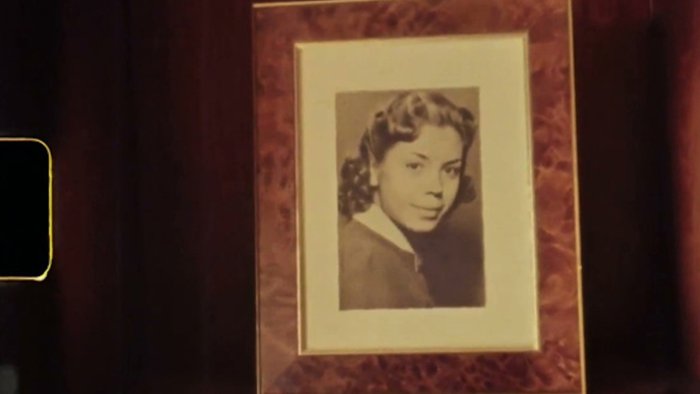
Dominga Sotomayor, Carla Simón | ES 2020 | 19’ | Visions du Réel 2020, Medium Length & Short Films
Correspondence strikes with a generosity of imagery and a wealth of history that spills out from Dominga’s initial sorting through of the “multitudes” contained within her late grandmother’s apartment. The title points to the epistolary form in which the two autobiographical directors (Summer, 1993 2017, and Tarde para morir joven, 2018) connect with one another through video tapes, objects, photographs and other diaristic means. Voices weave together to express anxieties: Should I have children? Would that prohibit my filmmaking? Another function of the form of diaristic exchange is that it reveals the moments the directors witnessed the material they would then fictionalise in their narrative features. They stretch from the everyday — an adoptive mother cradling peaches in an orchard — to the less so — the explosive end to the Pinochet dictatorship. It is a fascinating glimpse into the channels of memory and autobiography. Their voices and self-portraits weave together continuing, as it happens, in the festival’s Carte Blanche “introduction”. The two minute YouTube clip is split between two portrait-oriented phone screens showing the parallels in the filmmaker’s quotidian. The filmmakers’ physical separation (Barcelona/Santiago) is underplayed by their screen alignment. To me this highlights one merit of our socially distanced society: we align when we correspond. It makes for a charming first watch and a very warm welcome to the festival.
Laura Davis
This article contains a third-party video. If you would like to watch the video, please adjust your settings.
Mackenzie Reid Rostad | CAN 2020 | 37’ | Visions du Réel 2020, Medium Length & Short Films
A bold and suggestive cinematic essay that embodies a vision of film that I would like to come across more often – namely as a point of convergence between personal journey and philosophical investigations. The young filmmaker intertwines his longing for love with an inquiry into the social construction of time, the materiality that underpins the production of electricity and (therefore) light pollution. The director commands the dialogues quite well and overlaps between these seemingly unrelated themes, notably through a stupendous (sound) editing that creates a sense of floating somewhere yet unknown in a nearly preconscious state. Film experience amounts then to the delight of losing oneself in the empty spaces between image and sound, past and present, light and darkness, where ambiguity is always a virtue. Due to its refreshing and poetic vision, it might be the first piece of a body of works to come which I could easily imagine finding its place among the masterpieces of Montaigne, Sebald or Peter Mettler.
Emilien Gür
This article contains a third-party video. If you would like to watch the video, please adjust your settings.
Maddi Barber | ES 2020 | 50’ | Visions du Réel 2020, Medium Length & Short Films
Quelques branches d’arbre émergent à la surface de l’eau. L’image est empreinte d’une beauté douloureuse. Elle parle d’un monde qui n’est plus. Ces fragments végétaux valent comme signes d’une réalité qui disparut, lorsqu’en 2003, l’activation du réservoir d’Itoiz engloutissait sept villages et trois réserves naturelles dans les Pyrénées. Maddi Barber avait déjà consacré un court-métrage à ce territoire brutalement reconfiguré. Dans Above 592 Meters, la cinéaste filmait le quotidien d’une éleveuse et d’un garde champêtre, dont elle interrogeait le rapport aux animaux dans une nature reconstruite. Il s’agissait alors d’observer comment la vie se réorganisait au-dessus des eaux. Land Underwater se pense sur l’autre face de ce territoire : méditation sur non pas ce qui a survécu, mais ce qui a été perdu, détruit, spolié. Méditation et médiation, car le territoire perdu ne peut parler que par des intermédiaires. À savoir : des images filmées par des activistes, qui tentèrent d’empêcher la construction du réservoir, la parole des anciens habitants des terres inondées, qui, dans leurs rêves, retournent dans leurs foyers perdus, des traces qui, au sein du territoire actuel, suggèrent l’existence d’un monde englouti. Il ne s’agit pas de retrouver un paradis perdu, mais plutôt de raconter la perte. De même, ce n’est pas un film sur la mémoire d’un territoire disparu ; c’est le film lui-même qui devient cette mémoire, toute la mémoire d’un monde. Il est comme la vallée, dont les eaux mortifères peinent à cacher la vie qui y florissait avant : sous son calme apparent gronde la colère et la douleur de celles et ceux qui jamais ne pardonneront.
Emilien Gür
This article contains a third-party video. If you would like to watch the video, please adjust your settings.
Diego Benevides | BRA 2020 | 17’ | Visions du Réel 2020, Medium Length & Short Films
It is a small, sparkling diamond of a film. Precise cadrages and sensitive tableaux – almost without words, but with a lot of secondary noise that becomes the primary noise (whispering, spoons rattling against tin plates; the crowing of a cock; a pig grunting; pounding mortars; flutes and drums; flip-flops clapping on the floor... ) - elicit the most sensual moments and tender details from a small gift ritual in a Brazilian village, whereby the protagonist of the event become not the dogs that are given the gift, but a fruit design on a tablecloth, as many of us might recall from our grandparents. Sacredness lies in tenderness. The high “angel” perspective on the colourful tablecloth creates something that Jeff Koons does not achieve in the monumental. Folk art becomes pop art and pop art becomes folk art once again. An object acquires symbolic meaning, and yet it is appreciated above all in its concreteness and materiality: as a literal carrier of events, and as a material connecting animal and human.
Matthias Wittmann
This article contains a third-party video. If you would like to watch the video, please adjust your settings.
Antoine Chapon | FR 2020 | 19’ | Visions du Réel 2020, Medium Length & Short Films
If Herakleitos says that those who are awake have one and the same common world, while everyone who sleeps turns to his own dream world, then this eye-opening and, at the same, oneiric film entitled My Own Landscapes demonstrates the opposite: If you believe that you have set up your own dream, your paradise, your island in the virtual world, in order to inhabit this Elysium like a blessed unicorn after a life with the uniform, you will finally realize that there is nothing more uniform than your dream. In the end, all traumatized, virtualized, uniformed bodies come together to share your uniform dream, in an endless loop of idle skills or scripted shell shock symptoms; like the supposedly marginal, almost forgotten natural image background of your war memories that has always been prepared for you and preparing you, to be finally chosen by you as the ideal mise-en-scène of a desired natural experience: your own landscape. An innocent present time that serves as a screen memory to screen (= cover) all the layered surfaces of your past, surfaces that turned out to be not so comfortable any more. Please, change the mood! You are never alone when you dream. You are never innocent when you dream. There was always someone before you, someone who has arranged everything, every tree, the whole uniform mise-en-scène so that you can continue to believe that you have created your own exile. This exile turns out to be even more traumatizing than the trauma to be covered. «Whenever a place is called paradise, it is ruined forever« (Paul Theroux). It's a film about body (memory) snatchers. About your virtual self, cannibalising the body of your memory. It’s a film about virtual auto-cannibalism.
Matthias Wittmann
This article contains a third-party video. If you would like to watch the video, please adjust your settings.
Pierre Borel, Lea Lanoë | FR-DE 2020 | 18’ | Visions du Réel 2020, Opening Scenes
It is very hard to take yourself seriously when you catch your reflection in a spoon. Your nose is blown out of proportion and your tiny body dangles below. You’re goofy and warped: a cartoon. I think of John Ashbery's Self-Portrait in a Convex Mirror: «the soul establishes itself. / But how far can it swim out through the eyes/ And still return safely to its nest? ». On the Other Side of the Spoon is a portrait of musician Tristan Honsiger who recalls his life’s travels. It is with this slanted self-awareness that he performs for us. He is a cartoon character here to play, existing in the moment alone. Stringed instruments, I would like to suggest, can be some of the most experimental. Tristan Honsiger does away with notation, tonality, rhythm: many Western standards of musical beauty. It can totally reject harmony and common sense. What completes this film is the editorial style. The rhythm and tonality match the character’s warped sense of style: directors Pierre Borel, and Léa Lanoë employ non-conventional framing devices - heightened grain, blown out exposure and negative film. It is “the reflection once removed”. Looking at someone else’s reflection in a spoon, we realise how flat and two dimensional the mirror is: «the soul is a captive, treated humanely, kept / In suspension, unable to advance much farther / Than your look as it intercepts the picture. » A small but very powerful statement piece.
Laura Davis
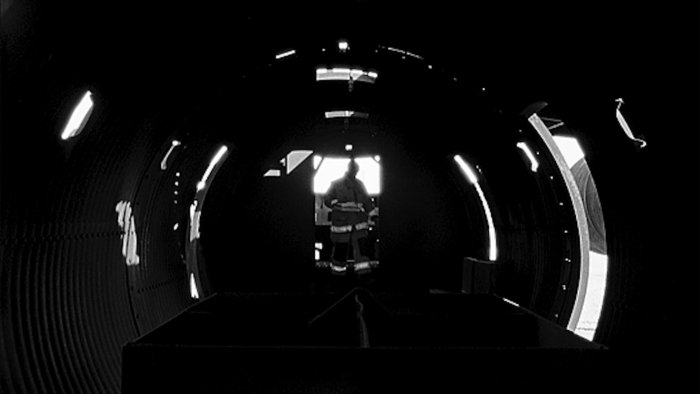
Kevin Jerome Everson | USA 2020 | 20’ | Visions du Réel 2020, Medium Length & Short Films
Artist filmmaker Kevin Jerome Everson’s latest short is structured around young African American airmen training in Columbus, Mississippi. In a take that lasts the duration of the film a young cadet sits on a rotating chair and is given instructions and asked questions by an invisible commander. The young man counts to ten. He is sometimes asked to respond to the interviewer with a number. Always zero. Everson’s lack of exposition decontextualizes this. Does the zero designate compliance, ambivalence, obligation, painlessness or something else perhaps? Implicit in this intercutting of uniformed bodies is the search for pain; the search for a person. This portrait of one working-class African-American community is typical of Everson’s body of work: a prosaic situation choreographed into staged abstraction. Cut into the picture (but not the soundtrack) are uniformed officers carrying out border checks, aircraft checks, searches for explosive devices. The voices are silenced, the audience subsumed into the machine. The coded Orwellian doublespeak in which the central subject is interrogated – «are there still maggots with us right now? » - is sickening.
Laura Davis
This article contains a third-party video. If you would like to watch the video, please adjust your settings.
Vinícius Lopes, Luciana Mazeto | BRA 2020 | 37’ | Visions du Réel 2020, Medium Length & Short Films
The Brazilian forest and a German colony, Teewald: two elements that are enough to raise the question of hybridity, and, following the reflections of the Turkish-German researcher Ilhami Paker, identity is a puzzling topic, scattered not only through geography, but throughout history. Vinicius Lopes and Luciana Mazeto focus on the roots of the migration of German colonists in Brazil, at the beginning of the 19th century. Here migration and colonialism coalesce, as well as the roles of victim and perpetrator – a challenge for the post-colonial dogmas of current academy. Tales from a Gothic 19th century, the hallucinated coloured footage from the beginning of the 20th century and two contemporary voice overs coalesce equally in a filmic style that mixes the accurate and sinister simplicity of fairy tales with the heavy content of archive documents. Tradition becomes both a delusional fetish and a survival strategy. The exaggerated gaiety of the final song will sound like a comic relief, but not without the bitter taste of the awareness of sorrow and impossible innocence.
Giuseppe Di Salvatore
This article contains a third-party video. If you would like to watch the video, please adjust your settings.
Laila Pakalnina | LVA 2020 | 12' | Visions du Réel 2020, Medium Length & Short Films
Modernist or simply modern, the Kraslava bridge is the first bridge on the Daugava river, near Latvia’s border with Belarus, but Laila Pakalnina’s film has no (overtly) geopolitical intentions, rather imposing itself as a wonderful meditation on architecture and landscape. The apparent formalism is never an end in itself. Through images that play with abstraction – but also with goats, bushes, and snow – she finds a way to make the bridge and its role something problematic. The bridge becomes an open question, an interrogation mark in the landscape where the perpendicular line of the river tries to resist. This is clearly the question of the tension between omnipresent nature – which embodies a quirky but firm point of view – and culture. The stories of people on or under the bridge follow in our imagination.
Giuseppe Di Salvatore
This article contains a third-party video. If you would like to watch the video, please adjust your settings.
Alex Evstigneev | RUS 2020 | 20’ | Visions du Réel 2020, Opening Scenes
How goes the life of children and teens in Moscow’s Presidential Cadet School? What is behind their daily exercises and routines? This is the object of inquiry of Alex Evstigneev’s new documentary, entitled The Golden Buttons. The film opens with a shot showing the detail of boots marching imperiously on wet asphalt. This is followed by a scene during which the instructor claims that «everyone can accomplish a heroic act in their life» and it was the cadets’ “free choice” to join the National Guard. The Golden Buttons conveys its core message through two aesthetic levels; the first is represented by the recordings of the cadets’ testimonies, who, more or less lucidly, share their concerns about their family, future and military life; the second is comprised of a series of intense medium close-ups, portraying the cadets looking at the camera, where the background is blurry but the surrounding environment is still recognisable. The first level provides mostly contextual, factual information, whilst the second, through the students’ eloquent silences and eyes, is perhaps the most interesting one and tells much more about the youngsters’ “free choice”. The final scene, powerfully evocative and beautifully shot, opens more questions about Russia’s current regime and the cadets’ indoctrination.
Davide Abbatescianni
This article contains a third-party video. If you would like to watch the video, please adjust your settings.
Otávio Almeida | CUB 2020 | 18’ | Visions du Réel 2020, Opening Scenes
Jeux de mains, jeu de vilains. Qui plus est quand le jeu consiste à manier pistolet et insultes à même de terrasser son pire ennemi. Les deux gamins d’une douzaine d’années de cette comédie cruellement drôle personnifient l’histoire cubaine en ses mythologies les plus assommantes. Et ces deux guérilleros de pacotille précisément de s’assommer jusqu’à ce que mort s’ensuive ! Leurs confrontations et provocations réciproques, d’abord muettes puis logorrhéiques, simulent une guerre qui renvoie explicitement à l’intervention militaire de Cuba en Angola en 1975 (38 000 soldats envoyés, près de 10 000 tués). L’un des deux enfants fantasme le récit d’un soldat de l’UNITA, auteur d’un viol, qu’il dut cribler de balles — pour mémoire, l’UNITA, les anticommunistes de la Guerre d’Angola, étaient les ennemis jurés des castristes. Un moment décalé par rapport aux scènes de lutte fait diversion : une méditation sur les cauchemars, la maladie, la mort et les raisons qu’il y a à vivre. Ces paroles incarnées dans ce jeu de rôles, dont les dialogues ont été co-écrits par les garçons, paraissent émouvantes et désarmantes. Quant à la figure du père, elle hante le film. Ancien soldat, sans doute, revenu des coulisses du passé, tatouage du Che à l’épaule, il est mutique. Otávio Almeida, cinéaste brésilien étudiant de l’EICTV à Cuba, tient corps à corps ses personnages en une mise en scène minimaliste et pour partie improvisée. Le ressassement de ces histoires, y compris la paranoïa face aux traîtres de la Révolution, prend un sens impressionnant dans le plan du sommeil du père et des garçons ; on en éprouve la lourdeur moite, et imagine ses cauchemars d’affrontements stériles. Lucide, distancié, sensiblement intelligent, ce film distille une vision critique d’un pays qui ressasse dans un dénuement accablant ses fantômes épuisés.
Jean Perret
